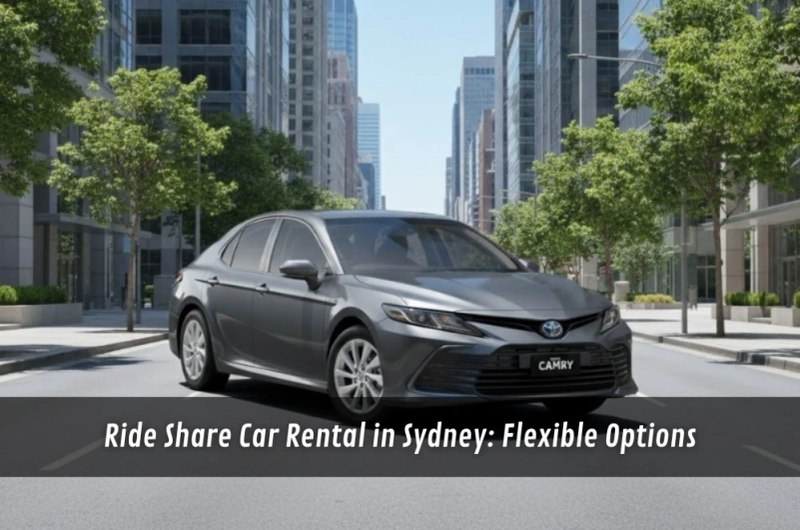Starting rideshare in Sydney shouldn’t require buying a car tomorrow. That’s the charm of rentals: you can get on the platform, test real earnings, and tweak your routine without a long-term commitment. If you’re weighing providers and contract styles, begin by shortlisting car rental for ride sharing so you’re comparing like-for-like inclusions—kilometre limits, insurance excess, platform eligibility, and service intervals—rather than just a headline daily rate.
Why renting makes sense when you’re testing the waters
Buying a car for rideshare can tie you to repayments that outlast your enthusiasm. Renting flips the risk profile:
- Low commitment: Pause or return the vehicle if your schedule or goals change.
- Predictable costs: Daily/weekly fee covers the car, rego, servicing (and often roadside), so budget variance narrows.
- Fleet fit: Access vehicles that already meet platform requirements—no surprises at onboarding.
- Upgrade path: Shift to a more efficient or larger model as your bookings and routes evolve.
When I trialled weekend night shifts, I used a rental for a month to map demand. By week two, I’d shifted my hours and neighbourhood focus, and the car went back after my test period—no stress selling a used vehicle three weeks later.
The decision framework: Matching the car to your shifts
Think like a tiny transport business. Your choice of vehicle arms you with (or drains) margin.
- Fuel efficiency: If your trips are mostly inner-city and short, smaller engines or hybrids tend to win on fuel spend.
- Boot and back-seat space: Airport runs and shared rides benefit from good luggage room and easy ingress.
- Comfort features: Adaptive cruise, decent seats, and quiet cabins reduce fatigue and keep ratings high over long stints.
- Platform eligibility: Confirm the model meets the exact category you want (e.g., standard vs. premium tiers).
Ask providers for a recent fuel-use snapshot from comparable drivers. Even a rough litres/100 km reality check helps you avoid models that look cheap upfront but bleed at the bowser.
Cost anatomy: Read the whole fee, not just the daily
The “$X per day” pitch hides a lot. Break every quote into the same parts:
- Base rate: Daily or weekly fee; confirm minimum term and notice period.
- Kilometre policy: Unlimited vs. capped (and the per-km overage). Capped kilometres can erase a low daily rate fast.
- Insurance excess: What’s included? Cost to reduce the excess? What counts as avoidable damage?
- Bond/holding deposit: How much, how fast it’s released, and in what circumstances it’s partially retained.
- Servicing & tyre rotations: Who pays if the car is due during your tenure? How are swap-overs handled?
- Roadside & replacement: 24/7 roadside included? If the car is off the road, how quickly is a replacement issued?
Once you have apples-to-apples numbers, blend in your expected kilometres and fuel burn to get an honest cost per working hour. A slightly higher daily rate can easily outperform a cheap headline once you include unlimited kilometres and a reduced excess.
Tax, GST, and the paperwork you’ll need
Rideshare income is taxable, and GST rules apply even if your turnover is under the general threshold. Before you commit to any rental, skim the Australian Taxation Office’s ride-sourcing guidance: ride share car rental nearby. It covers registration, BAS, and common deductions (e.g., a portion of your rental, fuel, tolls, and cleaning). Keep clean records from day one—kilometres, rental invoices, and toll statements. An ATO-friendly log makes tax time a tidy subtraction exercise instead of a panic.
Insurance and platform eligibility (don’t guess—check)
Two different things, both critical:
- Insurance: Confirm the policy type (comprehensive vs. third-party property), excess amounts, windscreen/tyre cover, and whether rideshare is expressly included. Ask for the PDS or a certificate noting rideshare use.
- Platform eligibility: Providers often partner with rideshare platforms and know which models are accepted. Still, verify the exact year/model/trim is allowed in your chosen category.
If a rental looks suspiciously cheap, it may exclude rideshare in the fine print—or bury you in a high excess. Neither is a bargain.
Pick-up, returns, and downtime planning
Time is money. Ask how pick-ups and returns work in real life:
- Pick-up location & hours: Airport-adjacent depots are handy after onboarding. Out-of-hours keys help if you swap vehicles between shifts.
- Service windows: Can you book a service during your off-hours? Will they provide a loan car during longer jobs?
- Damage assessment process: Clear, photo-led and fair? You should be able to document the car’s condition at pick-up and return.
I learned to take 30 photos at collection—panels, wheels, interior, boot, windscreen. It’s routine now, and I’ve never had a dispute stick.
A realistic first-month plan (so you don’t burn out)
- Week 1: onboarding + mapping demand. Do short shifts at different times (airport mornings, CBD afternoons, Friday/Saturday late). Track earnings per hour and per kilometre.
- Week 2: consolidate profitable windows. Double down on the two best dayparts. Note your fatigue levels—ratings follow how you feel.
- Week 3: refine routes and refuelling. Keep a cheap servo list and pre-shift top-ups. Every minute not driving or resting is margin leakage.
- Week 4: Review costs. Add rental, fuel, tolls, parking, and washes. Calculate your hourly net. Decide: keep, upgrade, or pause.
That rhythm is what helped me ditch two dead shifts that looked busy but paid thin when the numbers landed.
City smarts: Sydney quirks that change your P&L
- Tolls: M2, M4, M5, M7, Cross City Tunnel, Eastern Distributor, and NorthConnex add up. Price your routes accordingly and don’t chase pings across the city if they net pennies after tolls.
- Events: Moore Park, Olympic Park, and CBD concerts flip demand. Watch event calendars; short, strategic bursts can beat long, unfocused slogs.
- Airport rhythms: Early-morning arrivals can be gold, but waiting cold in the holding area isn’t always smarter than harvesting short CBD hops. Track both, then commit.
Provider checklist before you sign
- Rideshare-ready fleet: Vehicles already accepted on your platform/category.
- Transparent inclusions: Unlimited kilometres or clear caps, insurance details in writing, and roadside assistance included.
- Maintenance plan: Service intervals aligned to your kilometres, loaner access for longer jobs.
- Fair exits: Minimum term, return process, notice period, and any early-return fees spelled out.
- Reviews & references: Not cherry-picked—ask for a recent renter you can call.
If you’re after a deeper how-to on vetting contracts and inclusions, park an internal explainer here, ride share rental cars.
A compact vs. hybrid: Two lived-in scenarios
- Compact petrol hatch (inner-city shifts): Lower daily rate, nimble in tight streets, easy parking near hotspots. Fuel spend rises with congestion, but if your trips are short and frequent, the car turns jobs fast. I ran one for two weekends and found ratings jumped simply because passengers liked the clean interior and quick arrivals more than the badge.
- Hybrid (mixed airport + suburban): Higher daily rate, but fuel savings compound on long runs and stop-start traffic. If you target airport mornings and afternoon suburban returns, the regen braking plus efficient cruising can shave a noticeable slice off weekly fuel. I broke even on the higher fee by day three each week—then pulled ahead.
Neither is universally “best”. Your roster and routes pick the winner.
How to think about upgrading (or pausing)
Every four weeks, revisit your numbers and ratings. If your hourly net is capped by fuel and kilometres, a more efficient vehicle (or a category change) might help. If life’s busy next month, press pause; that’s the rental advantage. And if your ratings drift, fix the basics—clean cabin, water and mints, a consistent greeting—before you blame the car.
The wrap-up
Renting for rideshare in Sydney is a practical way to road-test the job without buying a car. The trick is to compare whole-of-week costs—not just the daily rate—then choose a vehicle that matches your shifts. Confirm platform eligibility, read the insurance and excess carefully, and keep clean records for tax time with the ATO’s ride-sourcing rules as your compass: ride share car rental. If the numbers stack up, lean in; if they don’t, return the keys and try a different configuration next month. Flexibility is the feature—not the footnote.



